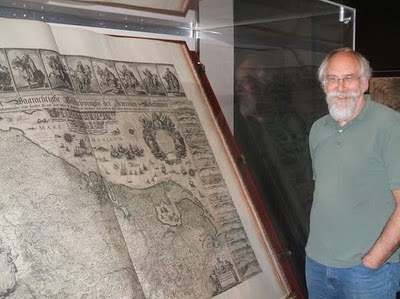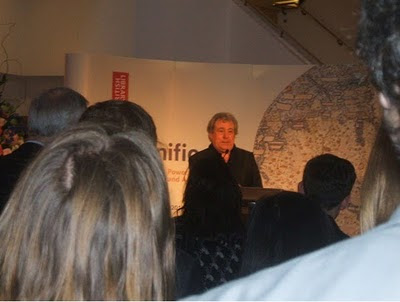Guest Post: Opening of British Library Magnificent Maps Exhibition
Guest Post: Opening of British Library Magnificent Maps exhibition
A Special Guest Post by Steve Chilton Manager of e-Learning Academic Development at Middlesex University & Chair of the Society of Cartographers

Steve Chilton with the huge six-by-three feet (0.9m×1.9 m) when closed, Klencke Atlas.
The great and the good (plus myself) met in the grand foyer of the British Library for the opening of the Magnificent Maps exhibition. Guest of honour was Python Terry Jones who reckoned he got the gig because he had once managed to carry off hosting a 4 hour radio programme on Medieval Maps. He recounted stories of learning about maps when playing at being soldiers in his school days. This included getting the coords completely wrong and sending the whole troop to the wrong locations when he was NCO.
Terry Jones (from Monty Python) Opening the Magnificent Maps exhibition.
He also got a dig in at Satnavs – suggesting they were equivalent to reading a book on a selection of cards with one word on each. When discussing the Mappa Mundi he also reminded us that the original translation of mappa was tablecloth – which had some resonance later when we viewed the exhibition and saw the immense size of some of the exhibits and the materials they were produced on. He had a nice line in blaming Washington Irving for the whole flat earth movement, because (as biography of Christopher Columbus) Irving introduced the erroneous idea that Europeans believed the world to be flat prior to the discovery of the New World, and this was taught to American schoolchildren for generations.
Following the speeches, and previously a little wine and canapés, we were invited to view the exhibition. It is housed in a series of 10 rooms or settings, which attempt to place the exhibits in themes that reflect their original purpose or location. The publicity claims that “beautiful and valuable maps have adorned walls since Roman times and even earlier, making statements about their owners’ power, taste and influence”. There are certainly some beautiful maps on display, and some apparently that are rarely available to view, and allegedly one that has just been discovered in the vaults after 500 years (exactly how do they know it has not been out for that long? but no matter). The settings include an audience chamber, a merchant’s house, a schoolroom, and a bedchamber. I looked at as much as possible in the exhibition, but was inhibited by two factors.
Firstly there were a lot of people in the way, and I really wanted a private showing!Secondly, and more seriously, there is just so much to see that I am going to be going back at least one more time (and possibly more) to take in more of the details.
For the moment I will just share six first impressions that I noted down that particularly interested or intrigued me. In no particular order they were: a map of Marco Polo in Asia – with a magnifying glass that you physically moved around but which was actually just a digital place marker to tell the software which bit to enlarge (it was projected onto a tablet); a map of Canton for Foreigners painted with distemper; a large set of room dividing screens covered in detailed maps; the detail in Stephen Walter’s London for Insiders map; the relief depiction on Carte de la Frontiere Turco-Persane; and the woodcut Birds Eye View of Venice from 1500.
I took (with permission) a picture of myself by the huge Klenke atlas, which you normally pass closed up in the foyer to the BL Map Room, and which is now open on a double page spread for study and is mightly impressive, allegedly the largest atlas in the world. If you have been watching the BBC4 maps series you will have seen three men carefully moving this exhibit from it’s normal to it’s temporary location. Every single exhibit is worthy of it’s place, and truly reflects the magnificent holdings of the British Library. You do just wonder what more treasures there are in the other 4.5 million maps in the BL that aren’t on show here. Working on a research project on early OS maps in the BL Map Room for over a year now I have sometimes seen curators Peter Barber and Tom Harper bring out sample maps to lay out and discuss for possible inclusion, and have not been able to resist looking at them curiously (the maps not the curators!). The aforementioned curators have also compiled an excellent book linked to the exhibition, which is now awaiting my attention.
Along with the recent BBC Radio 4 programme with Mike Parker (who told me he is about to do a trailer for the BL exhibition in Welsh for Radio Wales), the two recent BBC TV programmes, this exhibition really brings maps to the public in an accessible way. As noted I shall be going back to revisit it, and really consider it a must visit experience for all cartophiles.
Sources:
Link to exhibition : http://www.bl.uk/
Link to exhibition blog: http://britishlibrary.typepad.
Link to photo of Terry Jones: http://twitpic.com/1jgix2
Link to photo of Klenke atlas: http://twitpic.com/1jgiqx
Many thanks to Steve for sharing his experience of the British Library Magnificent Maps Exhibition.
Labels: British Library, Cartography, Guest Post, Magnificent Maps Exhibition, Steve Chilton







0 Comments:
Post a Comment
<< Home